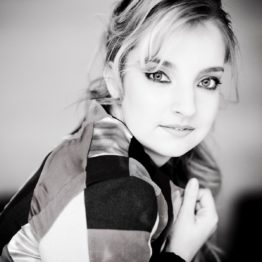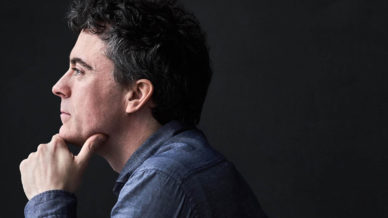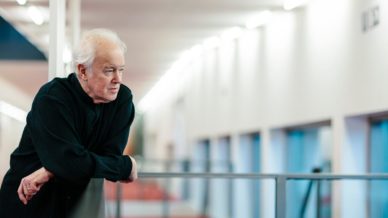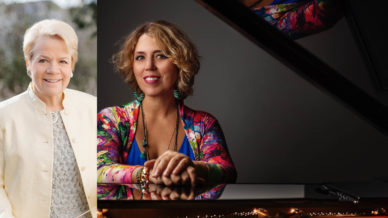

Fabio Luisi & Pianist, Lise de la Salle
November 4 – 6, 2022
FABIO LUISI conducts
LISE DE LA SALLE piano
JULIA PERRY Study for Orchestra
CLARA SCHUMANN Piano Concerto
LOUISE FARRENC Symphony No. 3
Leading into our Women in Classical Music Symposium, we invite you to explore the work of three female composers who dared to make a difference in the world of classical music. The lesser-known, but no less deserving, Julia Perry and the great Clara Schumann and Louise Farrenc were highly educated and internationally trained musicians. These talented women helped pave the way for female artists, like our soloist Lise de la Salle, whose playing inspired the Washington Post to write, “For much of the concert, the audience had to remember to breathe… the exhilaration didn’t let up for a second until her hands came off the keyboard.”
An African-American composer and conductor born in Kentucky, Julia Perry studied at Westminster Choir College and then Juilliard. Many of her early works are vocal, often incorporating influences from black spirituals. But she also studied with Luigi Dallapiccola at Tanglewood and in Italy, and she also worked with Nadia Boulanger, winning the Boulanger Grand Prix for her Viola Sonata. Her catalog includes a dozen symphonies and a pair of piano concertos; her theater works include three operas and a ballet, several on her own librettos or scenarios.
Most of this is sadly neglected, but her Short Piece for Orchestra (also known as Study for Orchestra, 1952) was recorded in a live performance by the New York Phil- harmonic under William Steinberg in 1965. It is an initially raucous, highly energized essay, brilliantly scored. There are edgy lyrical contrasts, however, and the work closes in a haunted Lento, before a whip- lash ending returns the aggressive opening thunder. — John Henken
Clara Schumann embarked on her Piano Concerto in A minor, Op. 7, not only at a pivotal moment in her own musical development, having previously focused on ‘small forms’ (Kallberg, 1992), but also in the history of the genre. To write a piano concerto in the 1830s was to engage with an established tradition that was in a state of change. Significant in this regard were the continued advancements in the modern piano, the expansion of form, evolving relationships between the soloist and the orchestra, and shifting attitudes towards virtuosity, all of which gave rise to new ways of navigating the nineteenth-century piano concerto.
Louise Farrenc (1804–1875) studied under Anton Reicha and worked in Paris for decades as a respected composer, pianist and music scholar. In 1842 she was the first woman to be appointed to the position of professor for piano at the Conservatoire National, a position she held for 30 years.

Program Notes
by René Spencer Saller
Even after suffering a debilitating stroke in 1971, Julia Perry persisted in composing,
building up a substantial body of work, in numerous genres. Her catalogue contains
more than a dozen symphonies and at least three operas, all of high quality. But if
you don’t recognize her name, please know that this has nothing to do with her
talent, which was formidable, and everything to do with her status, or lack thereof,
as a Black woman in the mid-20th-century United States. Until recently, Perry, like
the two other female composers presented in this concert, has been woefully
neglected on concert programs. During her own lifetime, racism and sexism
challenged but never deterred her; if anything, she worked harder to chart her own
path. Her revelatory compositions deserve—and reward—our attention.
Perry, the fourth of five sisters, was born in Lexington, Kentucky, to a schoolteacher
mother and a physician father, who once played piano well enough to accompany
the celebrated lyric tenor Roland Hayes in concert. The family moved to Akron,
Ohio, when Perry was 10. She earned a scholarship to Westminster Choir College, in
Princeton, New Jersey, where she studied voice, piano, and composition, and then
Juilliard, which led to her first Guggenheim Fellowship.
In 1948 Perry earned her master’s degree and presented her secular cantata
Chicago, a setting of a 1914 Carl Sandburg poem. She went on to study with the
influential teacher Luigi Dallapiccolla, at Tanglewood and, in Fontainebleau, outside
of Paris, with the legendary Mlle. Nadia Boulanger, who taught everyone from Aaron
Copland to Astor Piazzolla.
In 1952 Perry won the Boulanger Grand Prix for her Viola Sonata. She also won a
second Guggenheim Fellowship, which allowed her to study with Dallapiccolla again
in Italy. The premiere of her Study for Orchestra was a high point of her second stint
in Italy. With the vocal composition Stabat mater, Study for Orchestra would become
one of her most-performed works and one of the few pieces from her catalogue to
be recorded during her lifetime. During the summers of 1956 and ’57, she studied
conducting in Siena and directed a series of concerts in Europe for the Information
Service of the U.S. State Department.
Perry wrote her final five symphonies while contending with serious health
conditions and a long hospitalization. These include her Symphony No. 11 (“Space
Symphony”), Symphony No. 12 (“Simple Symphony”), and the Marching Band
Symphony. She also wrote an opera about the Salem witch trials, Symplegades. Her
last known composition was Bicentennial Reflections, from 1977, a concise
meditation on the theme of American freedom for tenor, electric bass, and chamber
ensemble. On April 24, 1979, in Akron, Ohio, Perry experienced catastrophic heart
failure and died at age 55.
A Closer Listen
Perry wrote Study for Orchestra in 1952, during her second Italian sabbatical.
Sometimes called by its earlier name, Short Piece for Orchestra, the seven-or-so-
minute orchestral work is distinctively American, a bewitching concoction of the
European neoclassical tradition that Perry soaked up in the conservatories and the
richly syncopated African American musical vernacular, the bonded-by-blood
spirituals, gospel hymns, and jazz ballads that anchored her like family. In 1964, a
dozen years after its premiere, the New York Philharmonic performed and recorded
Perry’s Study for Orchestra during a European tour. Vividly scored, the piece
contrasts a hypnotic Lento passage with aggressive outer sections.
On January 13, 1833, the 13-year-old German piano prodigy Clara Wieck wrote in
her diary that she had begun to compose her first piano concerto. All she had
composed so far was a single movement, which she called a “concert rondo.” It
would eventually serve as the final movement of her Piano Concerto in A Minor.
“[Robert] Schumann will orchestrate it now so that I can play it at my concert,” she
noted, referring to her father’s piano pupil and boarder—and her own future
husband. Clara had been an international sensation before hitting puberty, and
Robert, despite being nine years older, was still struggling to make a name for
himself as a composer and critic.
More than anyone, even more than he believed in himself, Clara believed in Robert’s
genius. Even though he wouldn’t kiss her until her 16th birthday party, and he was
sporadically involved with other women, he had fallen for her, and the feeling was
mutual. (As she wrote in a letter to him, “When you gave me that kiss, I thought I
would faint.”) Unfortunately, her controlling (and, at least by contemporary
standards, abusive) father opposed the match and even filed a lawsuit to prevent it.
After a long and rocky courtship, conducted mostly by secret correspondence, Clara
and Robert eventually prevailed in court. They married on September 12, 1840, the
day before she turned 21: she called it “the most beautiful and the most important”
day of her life. Over the next 16 years, until Robert’s premature death in 1856, she
barely had time to practice on the family’s only piano, much less compose. She gave
birth to eight children, seven of whom survived infancy; supported her increasingly
delusional husband creatively, emotionally, and financially; supervised the servants
and balanced the household budget; and, despite Robert’s pathetic objections,
maintained a busy performance schedule.
After Robert died in a sanitarium, in 1856, Clara composed very little. As a touring
concert pianist, she devoted much of her life to promoting her late husband’s music
and ensuring his place in the canon. By the mid-19th century, concert culture no
longer demanded that virtuoso performers also write or improvise their own
material, as had been the case during her adolescence, when she wrote her Piano
Concerto in A Minor primarily for her own performance. Without the weight of
expectation, she felt less motivated to compose. Instead, she resolved to serve as
Robert’s loyal champion and a (probably) platonic muse to their younger friend and
frequent houseguest, Johannes Brahms.
Perhaps relevantly, before her father obtained sole custody of her after divorcing
her pianist mother, before he transformed the child into a world-famous prodigy,
she reportedly spent the first four years of her life deaf and mute.
The A Minor Concerto
At age 15, Schumann, then Wieck, posed for a portrait with one hand resting on the
keyboard, the sheet music for her own Piano Concerto in A Minor, Op. 7, within
reach: a sweet-faced, sad-eyed girl whose public image was carefully constructed by
her Svengali father.
She wrote her sole Piano Concerto between the ages of 13 and 15; she debuted it
publicly on November 11, 1835, at the Leipzig Gewandhaus, under the baton of her
friend and admirer Felix Mendelssohn. This premiere took place a couple of months
or so after her fateful 16th birthday party. In those days, piano prodigies were
expected to demonstrate mastery of harmony and counterpoint by performing their
own compositions or improvisations at recitals. As Anna Beer explains in her
essential Sounds and Sweet Airs: The Forgotten Women of Classical Music: “Because
Clara Wieck was a child prodigy on the piano, she became a child-prodigy composer
for the piano.”
Robert’s growing attention fortified her ego while weakening her father’s hold.
When she was only 12, he praised her as a composer, treating her as his creative
equal: “Have you been composing a lot?” he asked in his first surviving letter to her,
dated January 11, 1832: “And if so, what? Sometimes I hear music in my dreams—
what a composer you are!” She began dedicating compositions to him, including her
sublime Romance variée for piano, Op. 3 (1831–33).
Disappointingly, Robert commissioned and published a somewhat tepid-to-critical
review of her Piano Concerto for the journal he edited at the time. His future fiancée
was incensed not only because he didn’t review it himself but also because he must
have approved this unsympathetic review of a concerto that he had helped
orchestrate.
Defending herself, she reminded him that her audiences, which spanned the
continent, insisted on hearing immediate encores of her original material: “Of the
many pieces I played, my concerto was received the best…. Do you think I am so
unaware that I don’t know the faults of the concerto?” [But] there is no better
feeling than having satisfied an entire audience.”
A sharp but well-deserved dig: as they both were all too aware, Robert wasn’t nearly
as adept as his teenage fiancée when it came to satisfying audiences. Proving the
point, she took the concerto on tour for the next few years, presenting it some seven
times across the continent, including at one recital in Vienna, when audiences
demanded two encores of the finale.
Ignorant critics made backhanded compliments and sexist assumptions. As one
anonymous reviewer quoted by Beer opined: “If the name of the female composer
were not on the title one would never think it were written by a woman.” Another
critic attributed the composer’s bold harmonic choices to a woman’s “moody”
nature, adding that innovation often promotes deviance in “the daughters of Eve.”
A Closer Listen
Despite the composer’s youth, the Piano Concerto in A Minor is both accomplished
and daring. Her through-composed melodies, unusual key changes, and risky
modulations exude a Chopinesque perfume, never mind that Wieck began writing it
before Chopin’s piano concertos were widely known. On the other hand, it’s likely
that Clara, a precocious connoisseur who made her professional debut at the Leipzig
Gewandhaus at age 11, had heard Chopin’s music performed during her extensive
European concert tours.
There are no true pauses between movements: in what would become a Romantic
convention, if that’s not a contradiction in terms, each movement flows into the
next, linked by carefully considered segues.
Cast in A minor, the opening Allegro maestoso announces itself with a grand tutti
before interjecting a contrasting idea, a plangent wind refrain. The piano tosses out
some resolute scales before the orchestra returns. After a dramatic cascade of
downward arpeggios, the soloist plunges upward and launches into the first solo
cadenza, a delicately voluptuous, polonaise-like tune that soon sweet-talks the
strings into humming along. Overall, the movement is punctuated by dynamic shifts
and climactic crescendos and decrescendos.
Preceded by another segue, also labeled Romanze, the central Romanze, in the
distant key of A-flat major, eases into a rapturous stretto piano interlude, a dreamy,
druggy waltz. Call it a rhapsody in deep violet, call it what you will, but it blossoms
into a twilit colloquy with the cello, one of the most indelible duets in the repertoire.
And even if she is biting Chopin’s steez (debatable), who cares? Who can fuss about
influence while marinating in bliss? Does it matter that Chopin himself admired
Clara’s music?
For the Allegro non troppo finale, which is almost as long as the first two
movements combined, Schumann returns to the home key of A minor, decorating
the majestic polonaise idea with ornately virtuosic filigree. At once fierce and
tender, the finale represents the soloist’s—originally the composer’s—spotlight
moment. It is the only one of the three movements that was originally orchestrated
by Robert, although Clara likely revised it in the years afterwards, after numerous
live performances. The orchestra offers support and occasional friction, alternating
full-throated tutti sections with subtle, chamber-like accompaniment that sets off
the sparkling piano pyrotechnics.
Born Jeanne-Louise Dumont, in Paris, Louise Farrenc was the daughter and sister of
prominent sculptors. She grew up in a creative, mildly bohemian environment and
thrived, starting piano lessons as a young girl, under Cecile Soria, a pupil of Muzio
Clementi. Soon she was learning from such luminaries as Ignaz Moscheles and
Johann Nepomuk Hummel. She became a touring piano virtuosa a good decade
before Clara Schumann debuted at the Leipzig Gewandhaus. In 1819, at age 15, she
studied composition privately with Anton Reicha, an associate of Beethoven’s and
an esteemed faculty member at the Paris Conservatoire. Whether the young woman
ever took classes with Reicha at the Conservatoire remains unknown, but it seems
unlikely, since the composition coursework was limited to men at the time. Female
students could not enroll, at least officially, in any composition class at the
Conservatoire until 1870.
In 1821 Dumont married Aristide Farrenc, a flutist and music publisher 10 years her
senior. It proved a good match for her, giving her the freedom to pursue the kind of
music career that was usually off limits to women of her social class. The couple also
co-founded a leading publishing house, Editions Farrenc. In 1826 the Farrencs
welcomed a daughter, Victorine, who, like her mother, enjoyed a successful career
as a concert pianist.
In 1842 Farrenc was named a tenured professor of piano at the Paris Conservatoire,
a prestigious position that she would hold for the next 30 years. Underpaid for the
first decade of her employment, she demanded and received a salary equal to that of
her male colleagues after her 1849 nonet for strings and winds wowed critics and
audiences alike. Twice, in 1861 and 1869, she won the Prix Chartier of the Académie
des Beaux-Arts. She was praised by the likes of Hector Berlioz and Robert
Schumann.
Along with chamber music and works for solo piano, Farrenc wrote three
symphonies. She completed her Symphony No. 3 in G Minor, Op. 36, in 1847, and
debuted it two years later, at the Société des Concerts du Conservatoire, on the same
program as Beethoven’s Fifth Symphony.
Farrenc stopped composing in 1859, after her 33-year-old daughter, Victorine,
succumbed to a long illness. Despite her grief, she stayed busy, continuing to teach
at the Conservatoire until 1873 while also researching French Baroque keyboard
music for the 23-volume scholarly series that she was compiling and editing with
Aristide.
A Closer Listen
The first movement, a dramatic, richly textured Allegro, opens with a solitary oboe,
which spins out a theme that the strings caress and adapt before conjuring up a
ferocious coda. In the slow movement, a solo clarinet croons over velvety strings,
low brass, and muted timpani. The effervescent scherzo amps up the contrast, and a
satisfying woodwind-centered trio ensues before the final emphatic chords of the
finale, a contrapuntal delight.




